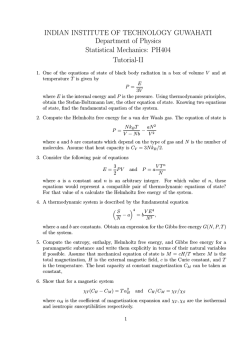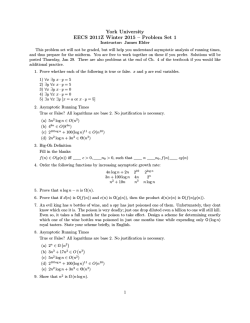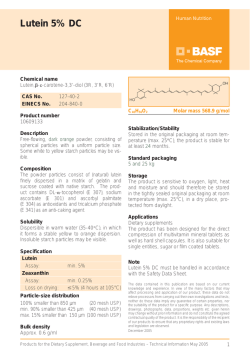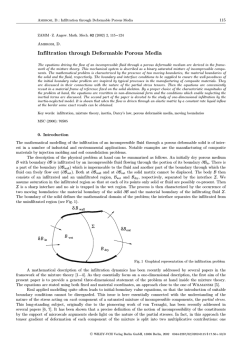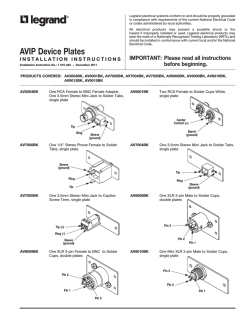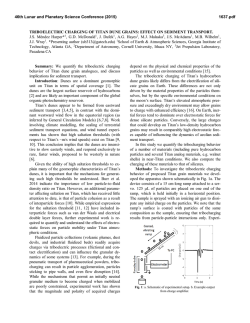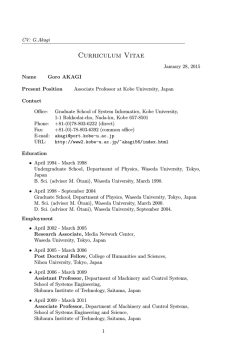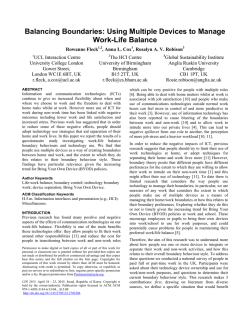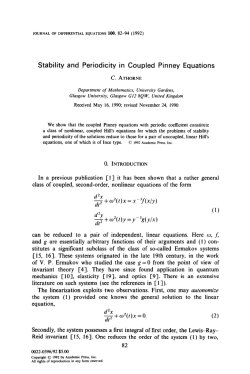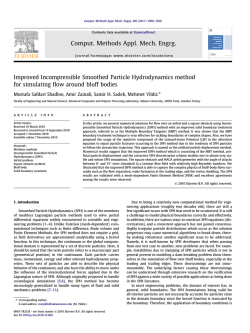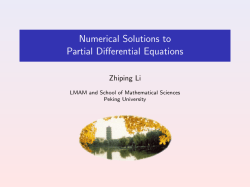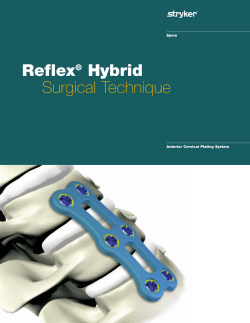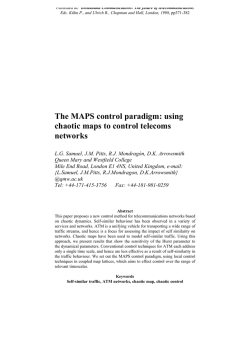
AN Osiptsov UDC 532.529
S T R U C T U R E OF TIIE L A M I N A R B O U N D A R Y L A Y E R OF A D I S P E R S E MEDIUM ON A FLAT PLATE A. N. UDC 532.529 Osiptsov A study is made of the stationary flow over a semi-infinite flat plate of a two,phase medium consisting of solid particles and a gas, which has a low viscosity. The aim of the paper is to investigate the influence of a difference between the velocities of the phases on the structure of the flow in the boundary layer. A similar problem was considered in [i-5], but the obtained solutions do not make it possible to follow clearly the development of the flow in the boundary layer or the change in the coefficient of friction along the complete length of the plate. In [i, 2, 4] no use was made of the projection of the momentum equation for the particles at right angles to the flow, and additional assumptions were made: constancy of the averaged density of the particles in the boundary layer in [i] and equality of the transverse components of the gas and particle velocities in [4]. In the monograph [2], only some oK the flow features were considered; these included the deceleration of the particles along the surface of the plate. In [3, 5], the solution is constructed by an expansion in power series in positive and negative powers of the longitudinal coordinate, it being assumed that far from the leading edge of the plate the averaged density of the particles in the boundary layer is constant. Below, the method of matched asymptotic expansions is used to construct boundarylayer equations for the flow region with velocity disequilibrium, and the asymptotic behavior of the solution is found at large distances from the leading edge. A numerical solution is used to study the distribution of the parameters of the phases and the change in the coefficient of friction over the complete length of the plate. I. The Boundary-Layer Equations The behavior of two-phase systems is usually studied in the framework of a model of two interpenetrating continuous media [6]. In the present paper, we restrict ourselves to the case oK an incompressible carrier phase and negligibly small bulk concentration of the particles. We assume that all particles are spheres of equal radius o, that the physical density of the matter of the particles is much greater than the density of the gas, Ps >> p ' and that the particles have no Brownian motion and do not influence each other. The Stokes force is used to describe the interaction between the continuous media in the entire flow region, including the boundary layer. As the estimates of [3] show, the other components of the interaction force between the continuous media must be taken into account when the physical densities of the particles and the carrier phase are nearly equal. We place the origin of a Cartesian coordinate system xy at the leading edge of the plate, and direct the x axis along its surface. In dimensionless form, the system of equations describing the motion of the suspension takes the form div V=O, div p:V:=O, (V' V) V§ § L l L ap:(V-V,) =-eAYL , (V:- V) V~ =--/-(V-V:) (1.1) IIere, the index s is appended to the parameters of the particle continuum, e = ~/v~p ~ l=mv~/6~G~, (m is the mass of a particle, v~ is the flow velocity at infinity, is the viscosity of the carrier phase), a=ps~/p ~ and L is the characteristic length Moscow. 4, pp. 4G-54, 512 Translated from Izvestiya Akademii Nauk SSSR, Mekhanika Zhidkosti July-August, 1980. Original article submitted December lO, 1979. 0015-4628/80/1504-0512907.50 9 1981 P l e n u m Publishing Corporation i Gaza, No. c h o s e n to m a k e the c o o r d i n a t e s d i m e n s i o n l e s s . T h e r e m a i n i n g n o t a t i o n is standard. As c h a r a c t e r i s t i c s c a l e s for m a k i n ~ the o t h e r q u a n t i t i e s d i m e n s i o n l e s s , we take v~ for the o2 v e l o c i t y c o m p o n e n t s of the two phases, p v ~ for the pressure, and Ps~ for the d e n s i t y of the p a r t i c l e c o n t i n u u m . On the surface of the plate, we m u s t specify the n o - s l i p condition for the c a r r y i n g phase: k=v=O In the unperturbed (1.2) flow, u=~,=p,=l, v=v,=O, p=p~ (1.3) ~ h e n one is c o n s i d e r i n g f l o w over a plate, the c h a r a c t e r i s t i c l e n g t h is u s u a l l y t a k e n to be equal to the d i s t a n c e from the edge of the p l a t e to the c o n s i d e r e d region. S i n c e the task of the p r e s e n t i n v e s t i g a t i o n is to a n a l y z e the i n f l u e n c e of the d i f f e r e n c e b e t w e e n the p h a s e v e l o c i t i e s on the s t r u c t u r e of the flow in the wall region, we set L = Z in our d e r i v a t i o n of the b o u n d a r y - l a y e r equations, s i n c e i c h a r a c t e r i z e s the dec e l e r a t i o n l e n g t h of a p a r t i c l e w h i c h e n t e r s gas at rest w i t h v e l o c i t y v~. W e shall a s s u m e that the v i s c o u s l e n g t h u/v~p ~ is m u c h less than i, i.e., ~ << I. We c o n s t r u c t an a s y m p t o t i c s o l u t i o n of the s y s t e m (i.I) as ~ + 0. The highest derivatives have a small p a r a m e t e r , and the s o l u t i o n of the d e g e n e r a t e p r o b l e m for s = 0 c a n n o t s a t i s f y the n o - s l i p c o n d i t i o n u = 0 on the p l a t e b e c a u s e of the r e d u c t i o n in the o r d e r of the e q u a t i o n s . In a c c o r d a n c e w i t h the m e t h o d of m a t c h e d a s y m p t o t i c e x p a n s i o n s [7], we find first the e x t e r i o r e x p a n s i o n , i.e., an a s y m p t o t i c s o l u t i o n of (l.1) v a l i d in the l i m i t E § 0 for f i x e d x and y. In a c c o r d a n c e w i t h the p h y s i c a l m e a n i n g , the ext e r i o r e x p a n s i o n is a u n i f o r m h o m o g e n e o u s f l o w 9u = u ~ = p ~ = l , v=v~=O, p = p ~ We To c o n s t r u c t the i n t e r i o r expansion, we seek the i n t e r i o r e x p a n s i o n in the f o r m introduce (1.4) the stretched k(x, ~ ) + . . . , k~(x, ~ ) + . . . , p~(x, ~ ) + p(x, ~)+ .... Y~u(x, ~)+ . . . . ~ ( z , Substituting ary-layer (1.5) in (!.X) Ok Ov Ox a~I Op~k~ =0, Ox ... (1.5) ~)+... the principal is to necessary to the parameters 4 ap,v, o~1 --O,u ok +V Ox terms, we o b t a i n the bound- O~l2 impose the boundary conditions of the exterior flow: (1.2) equations can be of boundary-layer , Op 0~1 =0 (1.6) a----~=k--k~, k~--d-Z+v~ a q =v-v~ k,~,p~l Similar by the method the particles. o~I O2a + ap,(k--u,)= ~ Or+ +v, 0~, Ok Or+ k, It q = ya -I/2. equations --+ matching and r e t a i n i n g variable as obtained from the corrections with on the plate and require ~ (1.7) boundary-layer neglect of the equations of [8] derived volume concentration of To construct a unique solution to the system (1.6), which is parabolic, we must specify the initial profiles of the functions u, Us, Os , v s . These functions must satisfy the conditions of matching to the asymptotic solution (i.I) in the neighborhood of the leading edge of the plate (L - ~/v~p~ i.e., where the assumptions under which the boundary-layer equations are derived are violated. We write down the equations for the principal terms in the expansion of the solution in the neighborhood of the leading edge. For this, we set L = D/v~p in (i.I) and let ~ tend to zero. We obtain the system divV=O, mining It can be seen the parameters that in of the divp~Vs=O, ( V . V ) V + V p = A V , the neighborhood phases separate: (V~.V)V,=O of the leading edge the for the carrier phase, problems we obtain for deter- 513 b J I / / 0.5 u, us 0 u,t 0 0.5 Fig. O.,J v,~ 0.5 u % I 0 0.2 v,~ Fig. Y 0 0.1 v,v~ 2 Navier--Stokes equations with Reynolds number equal to unity; for the particles, taking into account the conditions of matching to the external flow, we obtain Ps = Us = 1 and v s = O. As follows from the analysis of the first approximation, the first nonvanishing term in the expansion of v s in this region has the order c. The solution to the problem for the carrier phase, as in a homogeneous viscous fluid, is matched in parabolic coordinates to the Blasius solution of the Prandtl equations. Thus, for the boundary-layer equations (1.6) it is necessary to specify the Blasius profile as the initial conditions for u, and for the particles u s = Ps = 1 and v s = 0. This result has a perspicuous physical interpretation: at a distance of the order of the viscous length, interaction of the two phases cannot be manifested, since the deceleration length of a particle is by hypothesis much greater than the viscous length. 2. Results of For pa__rabolic ~xvs, X Numerical the numerical coordinates q:p,as, the system oz Solution x 2 solution, it is convenient and C = ~/~ and introduce (1.6) then becoming x ox to rewrite the the new unknown system (1.6) in functions w~v, 2 0 +~ ( the w~: ) 02t~ (2.1) Ow. + ( 2w. ~a~~ Ow. x ( ~ - ~ ) , xu~ ~x The boundary and initial conditions :9~ u~w~ + x(w-w.) ! O~ '~= 2 are u=w=O, ~=0, x~>0 u~=z~=q=l, ~=o% x~>0 zt~=q=l, w~=O, u=r ttere, ~(~) is the boundary conditions: Blasius function [9], which x=O satisfies 2~"'+~"=0 ~(0) =~'(0)=0, (2.2) the following equation and (2.3) r =1 (2.4) The system (2.1) with the boundary conditions (2.2) was solved numerically on a BESM-6 computer. An i m p l i c i t difference scheme with order of approximation Ax + AG 2 w a s use to approximate the equations on a rectilinear mesh. The sweep method was used to solve the difference equations in each x layer. The final calculations were made with mesh parameters Ax = 0 . 0 0 1 a n d A~ = 0 . 0 1 . As the results of the numerical calculations show, the flow structures for different values of ~ are of the same kind. In Figs. 1 - 3 , we s h o w t h e r e s u l t s of calculations of the parameter profiles for both phases in the boundary layer for a = 3. Figure 1 shows the development of the profiles of the longitudinal velocities of both phases with respect to the coordinate x, while the broken line shows the Blasius profile in a gas without particles. Figure 2 shows the profiles of the vertical components of the velocities of the phases. The graphs a), b), and c) correspond to the values x = 0.2, 1, !2, and the 514 indices 1 and 2 label the profiles of the carrying phase and the disperse phase, respectively. Over the complete thickness of the boundary layer, the longitudinal velocity of the particles exceeds that of the gas, and for x < 1 it is nonzero on the surface of the plate. The relaxation of the longitudinal velocities of the phases is terminated effectively at x = 5. At small x, there exists a range of 5 values for which v s < v, i.e., the particles intersect the streamlines of the gas along the direction toward the plate. At large x, we have v s > v over the complete thickness of the boundary layer. It should be noted that the relaxation of v and v s occurs over a much greater length than that of u and u s . Figure 3 shows the formation of the density profile of the disperse phase with the development of the flow along x~ curves 1-3 corresponding to the values x = 0.2, I, 12. For x < i, the density of the disperse phase increases monotonically as the plate is approached, and on the wall reaches a value equal to Psw = i/(i -- x). For x ~ i, Ps tends to infinity as the plate is approached. With the completion of the relaxation of the phase velocities, a strongly inhomogeneous profile of Ps is formed, and there exists a region of 5 values for which Ps < I. As can be seen in Fig. i, both phases become self-similar. Blasius profile of the argument equations for homogeneous fluid In Fig. 4, cf for the values have plotted we show ~ = 0, at large x the profiles This limiting profile z = ~(i + ~)I/2, i.e., with increased density of the longitudinal velocities of (see Sec. 3) coincides with the with the solution to the Prandtl O = ! + ~. the results of calculations of the 3, I0, 20 (curves 1-4, respectively). local coefficient of Along the ordinate friction we Here, T w is the local t a n g e n t i a l s t r e s s on the wall, and Re is the local R e y n o l d s number, in w h i c h the c h a r a c t e r i s t i c l e n g t h is t a k e n to be the v a l u e of the d i m e n s i o n a l c o o r d i n a t e x. For the f l o w of a h o m o g e n e o u s viscous fluid over a plate, cf=0.332/u For Eqs. (1.6), this case corresponds to the absence of an influence of the particles on the motion of the carrier phase, i.e., ~ = O. As can be seen in Fig. 4, the coefficient of friction for different values of a changes with increasing x from the values corresponding to the Blasius solution in a gas without particles (the asymptotic behavior o f c f a s x § O) t o t h e v a l u e s corresponding to the Blasius solution in a homogeneous gas with density p = 1 + ~, i.e., to values cj=0.332 (l+~)'~/~Re (2.5) (the asymptotic behavior of cf as x § In the entire flow region, except of very small x, the coefficient of friction exceeds the value corresponding flow, i.e., corresponding to the Blasius solution for homogeneous fluid with density. 3. Asymptotic Distances Behavior from the of the Leading Solution for for the region to frozen increased Large Edge To find the asymptotic behavior of the solution of the system (1.6), we construct boundary-layer equations valid in a region far downstream of the velocity relaxation region. For this, we set L >> l in the system (I.i). We denote I/L = 6(s with 6 § 0 as c § 0. In what follows, we shall label all the variables in this region by the index layer By analogy with variable~l~YJ(86) We seek the the method '~. solution within set the forth in boundary Sec. layer u,(x,, n,)+...., ~,(x,, ~,).+..., p,(x,, n,)+... Substituting ary-layer equations (3.1) in (i.I) and retaining i, we in introduce the a stretched boundary- form (e6)'%(z,, n,)+...., (e6)'~v,,(x,, ~,)+... the principal i. terms, we obtain the (3.1) bound- 515 0 ! 2 I t % g.5 t 2 Fig. 3 J .r- Fig. 4 Oui + Ovi = 0 , v . , 0p+t --+v, 0p,t : 0 , O.5 0 Fig. 5 ( l + a p ~ , ) (+, Ou, + Oa, \ -------, 02ui u+t=a,, v+i~-u, (3.2) The b o u n d a r y c o n d i t i o n s a r e a n a l o g o u s t o ( 1 . 2 ) and ( 1 . 7 ) . Note that the coordinates x 1 and x p l a y t h e p a r t o f e x t e r i o r and i n t e r i o r coordinates, respectively, for the flow region that is not in equilibrium with respect to the velocities; x 1 = 6x. The s o l u tion to the system (3.2) for x 1 + 0 must be matched to the solution (1.6) as x + ~, it__ / i being convenient to carry out the matching in the variables 5 and x, since ~=~/]x=~],/~x~, i.e., one moves from the region of nonequilibrium flow along the parameters 0/v~x = c o n s t . The f o r m u l a t i o n o f t h e p r o b l e m ( 3 . 2 ) d o e s n o t c o n t a i n 1, an d t h e r e f o r e the solution must be self-similar. We i n t r o d u c e the variable ~=~/u and s e e k t h e f l o w f u n c t i o n in the form ~ ( ~ x l ) = ~ , ( ~ ) . From (3.2), using the boundary conditions, we obtain (i+a)~cp~"+2~'"=O, The boundary conditions We introduce the function we obtain f r o m (3.3) take the form ~,(0) = ~ / ( 0 ) = 0 , For F(z), p~=l q,'(~) =i (3.4) F(z)=(1+~)v'~,(~), z=~(l+~) '~. (3.3) and (3.4) the Blasius law (2.3)-(2.4). For the velocity profile ul(~) we have a,(~)=~,'(~)=F'(z) (3.5) Therefore, the solution Ul(5) to the system (3.2) is identical to the self-similar Blasius solution of the variable z, i.e., to the solution of the Prandtl equations in a homogeneous fluid with density 9 = 1 + ~. The coefficient of friction in the considered region is found f r o m (3.5) and has the form of (2.5). The numerical calculations of the profiles of the longitudinal velocities of the phases and the coefficient of friction in the nonequilibrium region of the flow confirm the asymptotic solution that we have found; thus, already for x = 12 the profile u(~) in Fig. 1 virtually coincides with (3.5). The self-similar solution to the system (3.2) with constant density is obviously not uniformly applicable in the considered flow region, since an essentially inhomogeneous profile of the disperse phase in the wall region follows from the results of the numerical calculations (Fig. 3). This fact indicates the existence of a "thinner" (in the asymptotic sense) region in which the solution of (3.2) with P s l = 1 is not valid. We shall call this region the nonself-similar boundary layer. We shall denote the flow parameters --V2 "~14 in this region by the index 2. We introduce the new stretched coordinate ~2--y~6 6 . We shall seek the solution in this region in the form 6 ~ ( x , , ~D+..., 6v'u~(x,, 516 ~ ) + . . . . p~(x,, n ~ ) + . . . ~'~'6~ qD+..., ~v~6~ ~)+ ... (3.6) T h e orders of m a g n i t u d e the other regions. Substituting (3.6) we obtain the system __ are chosen to be consistent in (l.1) and retaining ~v~ Ou2.+ =0, Ox~ 0~2 matching Taking of into u 2 to 0p~2 , a2~vo Ox~ account the vanishing u I as ~2 § ~' we find ~=~,(0)q~(t• and m a t c h the solution in the equations 0p~z =0, " 0~ 02~ O~zz of u 2 and v 2 on from (3.7) --0, the for the principal az=u~2, plate and follows from the last the equation in (3.8) that the value of Ps2 i s (3.7) condition ap,~ 4x~ 0 ~ axr It v2~v~2 v2=~,,(O)~2~(t+a),~!xc~/4, ap~2 ~. ~ ' terms, of 0 (3.8) conserved along the curves ~2x71/4~ = const. The value of Ps2 must satisfy the condition of matching to ~ in the region of flow with velocity disequilibrium. Since the matching is conveniently done in the variables @ and x as x I § 0 and x + ~, respectively. Thus, the density profile calculated from (1.6) in the variables ~ and x must go over into the self-similar profile, which is the initial condition for Ps2' from the nonselfsimilar boundary layer. This result is confirmed by the numerical calculations. In Fig. 5, we show the profile i/Ps(@ ) calculated for a = 5 with x = 12; for x > 12, the results of the calculations are virtually coincident with the plotted graph. ~2x]I/t=~x-'~=O, Note that the influence of an inhomogeneous at large x does not have a strong influence on coefficient of friction in the region in which ended can be calculated approximately from the particles. density profile in the boundary layer the coefficient of friction, i.e., the the velocity relaxation has effectively Blasius solution for frozen motion of the In the case when the mass concentration a of the particles is negligibly small, all the results simplify significantly (it is sufficient to set a = 0 in all the obtained expressions). It is found that the particles do not affect the motion of the gas, and the Blasius solution in a gas without particles holds for the carrier phase. I thank V. P. Stulov for interest in the work and helpful recommendations. LITERATURE CITED 1. 2. 3. 4. 5. 6. 7. 8. 9. H. H. C h i n , " B o u n d a r y l a y e r f l o w w i t h s u s p e n d e d p a r t i c l e s , " Princeton Univ. Dept. A e r o n a u t . E n g . R e p t . , No. 620 ( 1 9 6 2 ) . Soo S a o - L e e , F l u i d D y n a m i c s o f M u l t i p h a s e S y s t e m s , B i a i s d e l l , Waltham, Mass. (1967). R. E. S i n g l e t o n , "The c o m p r e s s i b l e g a s - s o l i d particle flow over a semi-infinite flat plate," Z. Angew. M a t h . P h y s . , 16, No. 4 ( 1 9 6 5 ) . F . E. M a r b l e , " D y n a m i c s o f a g a s c o n t a i n i n g small solid particles," in: Combustion and Propulsion, Pergamon Press, Oxford (1963). L. S. Soo, " N o n - e q u i l i b r i u m fluid dynamics-laminar flow over a flat plate," Z. Agnew. M a t h . P h y s . 1_99, No. 4 ( 1 9 6 8 ) . R. I . N i g m a t u l i n , F u n d a m e n t a l s o f t h e M e c h a n i c s o f H e t e r o g e n o u s M e d i a [ i n R u s s i a n ] , N a u k a , Moscow ( 1 9 7 8 ) . J . D. C o l e , P e r t u r b a t i o n Methods in Applied Mathematics, Blaisde!l, Waltham, Mass. ( 1 9 6 8 ) . V. P. S t u l o v , " E q u a t i o n s o f a l a m i n a r b o u n d a r y l a y e r i n a t w o - p h a s e m e d i u m , " I z v . A k a d . Nauk SSSR, Mekh. Z h i d k . G a z a , No. 1 ( 1 9 7 9 ) . H. S c h l i c h t i n g , B o u n d a r y L a y e r T h e o r y , M c G r a w - H i l l , New Y o r k ( 1 9 6 8 ) . 517
© Copyright 2025
